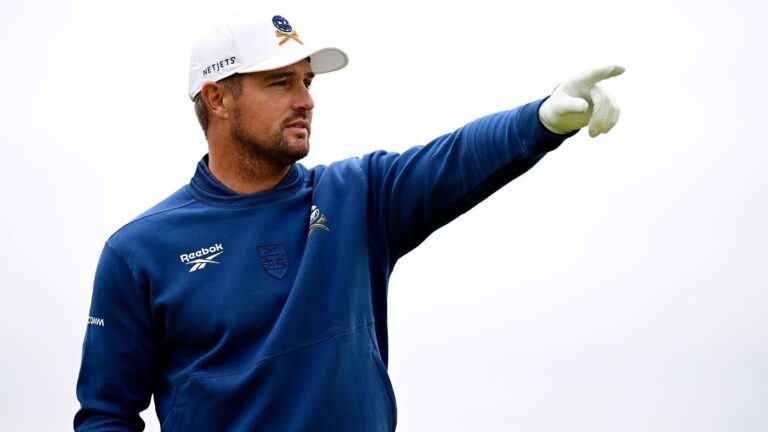Bryson DeChambeau is one of the most accomplished major championship golfers of this era. He has two U.S. Open titles, five other top 5 finishes and two more top 10s since 2020, but for all his success stateside, The Open Championship has been his Achilles heel in the major rotation.
Every American golfer has a learning curve for links golf, but some adapt to it quicker than others. Golf in the United Kingdom requires a different set of skills; it calls for more creativity and use of the ground than courses in the United States require. The biggest difference, though, is the weather; the cold, damp, windy conditions players see in The Open can be foreign for those who grew up in the warm climates where golf thrives in the U.S.
DeChambeau’s learning curve has been steeper than many of his top counterparts, as he has just one top 10 (T8 in 2022) and three missed cuts in seven starts at The Open. Wind has long been an enemy of DeChambeau as his scientific approach to golf has never quite figured out how to handle a factor that is so variable. Winds don’t impact the ball the same way all the time, and they’re constantly changing and shifting — in direction and strength.
That’s a challenge for every golfer, but for DeChambeau, who is so exacting and precise in his calculations before every shot, it’s created constant struggles. As he gets ready for another crack at The Open, DeChambeau spoke about the work he’s put in to being better in the wind.
“I’m still working on that. We’re doing some testing right now, going to continue to working on how heavy — how different types of wind affect the golf balls. It’s something I’m working on on a personal project, and it’s going to take time to understand it,” he explained.
“Heavy wind is a great way to describe it. It’s thick. … It’s one of those situations where you’re in the environment and you go, all right, this feels like a 15-mile-an-hour wind, and all of a sudden it plays like a 30-mile-an-hour wind, and you’re like, what the heck? So I think that’s the trick of it. If you grew up here, you play a lot of golf over here, you get quite comfortable and knowledgeable about that. I just need more reps in a sense.”
The Open 2025: Bryson DeChambeau among five major champions who have surprisingly struggled on links courses
Robby Kalland
DeChambeau highlighted recent quality play at the LIV Golf events in Andalucía and Miami that had stronger winds, but he noted the wind in the UK is different because the air is heavier, which impacts the ball differently. DeChambeau is still trying to figure out exactly how to play in the wind — highlighting some big ideas he has to truly experiment with wind golf.
“This is going to be wild, but imagine a scenario where you’ve got a 400-yard tent, and you can just hit any type of shot with any wind with all the fans,” DeChambeau mused. “That’s what I imagine, like in a hangar or something like that in a big stadium. That would be cool to test.”
Until he figures out how to make a golfing wind tunnel possible, he’ll have to stick with a more traditional method of getting reps when it’s windy. That has, at least, yielded one positive change in his game as he’s learned to play against the wind rather than with it.
“All I’ve really done is hit more half shots and tried to play into the wind a lot more. If it’s a left-to-right wind, I’ll draw it. If it’s a right-to-left wind, I’ll try to cut it more often than not,” DeChambeau said. “If I try to play with the wind, sometimes I lose control of the golf ball. That’s what I did. Whenever I had a right-to-left wind and I was trying to hit draws, man, that thing would go forever offline. Those are few things I’ve been working on.”
The question is just how much he’s figured out in his experimentation and whether that can produce the kind of concrete, empirical data he’s trying to find. DeChambeau spends his time trying to remove every possible uncertainty from his game, obsessively trying to eliminate any guesswork and know the exact shot to hit at the exact time.
The problem? Wind is never consistent, and that variability requires a certain feel that can’t be manufactured or perfected — even if he does build his giant golfing wind tunnel. The best at playing in the wind are able to take it out of the equation as much as possible with their trajectory, something DeChambeau’s upright swing makes difficult. However, even then, there’s a guessing game of exactly how much impact the wind will have — and whether it will gust up or lay down at any given moment.
The real battle with the wind is mental — not in the sense that one most to outthink the conditions but rather one must have a willingness to let go, accept the occasional miss and trust in your overall process.
Every golfer in the field this week is going to misjudge the wind or get gusted, but the ones who can put those misses out of their minds and commit to the next shot are the ones that will have success. Until DeChambeau is comfortable and confident enough in his process in the wind that he no loner second guesses himself, his uneven play at Open Championships will likely continue.
